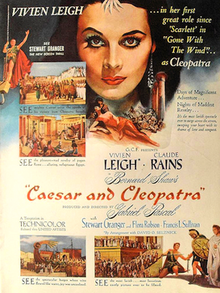Caesar and Cleopatra (film)
| Caesar and Cleopatra | |
|---|---|

theatrical release poster
|
|
| Directed by | Gabriel Pascal |
| Produced by | Gabriel Pascal |
| Written by | George Bernard Shaw (play (uncredited), screenplay (uncredited), dialogue, scenario) |
| Starring |
Claude Rains Vivien Leigh |
| Music by | Georges Auric |
| Cinematography |
Jack Cardiff Jack Hildyard Robert Krasker Freddie Young |
| Edited by |
Frederick Wilson Joan Warwick (uncredited) |
|
Production
company |
|
| Distributed by |
Eagle-Lion Films (UK) United Artists (US) |
|
Release date
|
11 December 1945 (London) 6 September 1946 {US} 16 September 1946 (UK) |
|
Running time
|
128 minutes (UK) 123 minutes (US) |
| Country | United Kingdom |
| Language | English |
| Budget | $5.2 million or £1.3 million |
| Box office | $2,250,000 (US rentals) 815,007 admissions (France) $1.4 million (UK) |
Caesar and Cleopatra is a 1945 British Technicolor film directed by Gabriel Pascal and starring Claude Rains and Vivien Leigh. It was adapted from the play Caesar and Cleopatra (1901) by George Bernard Shaw. The film was produced by Independent Producers and Pascal Film Productions, and was distributed by Eagle-Lion Distributors. St6aff (30 October 1946)
Caesar and Cleopatra was a box office failure, but it was nominated for an Academy Award for Best Art Direction for John Bryan.
In this philosophical coming-of-age film, an aging Julius Caesar takes possession of the Egyptian capital city of Alexandria, and tries to resolve a feud between young Princess Cleopatra and her younger brother Ptolemy. During the resulting sometimes-murderous court intrigues, Caesar develops a special relationship with Cleopatra, and teaches her how to use her royal power.
Filmed in Technicolor with lavish sets, the production was reported to be the most expensive film ever made in Britain at the time, costing £1,278,000.
Pascal ordered sand from Egypt to get the right cinematic color. The production also ran into delays due to being filmed during the Second World War. During the shoot, Vivien Leigh tripped and miscarried.
...
Wikipedia
